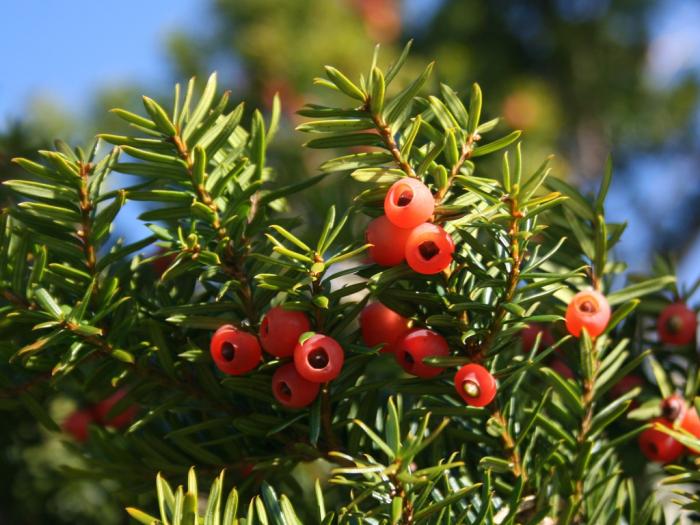Taxus cuspidata
Japanese Yew

Description
The Japanese yew is a woody evergreen tree or shrub in the yew family. It is native to Korea, China, Russia, and Japan. The name derives from the Latin word cuspidatus, meaning “prickly pointed,” which refers to the sharp, pointed tips of the foliage. Grow the Japanese yew in full sun, dappled sunlight, or in partial shade. It requires sandy or loamy, neutral to acidic soil with good drainage. This yew is tolerant of urban conditions and drought. It is also very cold hardy and easy to maintain. It tolerates pruning well and needs regular annual pruning to maintain its shape. Grown as a landscape specimen and pruned regularly, the height typically averages around 25 feet. Plant 6 to 12 feet apart. The needle-like foliage is dark green with a yellow-tinged underside and may turn reddish brown or yellow in the winter. The bark is reddish brown. Small red berries appear in the fall, attracting birds. It is an excellent choice for hedges and privacy screens and can be shaped as topiary. Use it as a specimen or accent plant on your lawn, in a patio, or along a walkway. It also works well in woodland settings. Bark, leaves and seeds are poisonous.
Plant Type
Tree, Shrub
Height Range
12-25'
Width Range
1-3', 3-6', 6-12'
Flower Color
n/a
Flower Season
n/a
Leaf Color
Brown, Dark Green, Yellow Green, Red
Bark Color
Brown, Red
Fruit Color
Red
Fruit Season
Fall
Sun
Full, Half
Water
Low, Medium
Growth Rate
Slow
Soil Type
Sandy, Loam
Soil Condition
Rich, Well-drained, Moist
Soil pH
Acid, Neutral
Adverse Factors
Poisonous
Design Styles
English Cottage, Formal, Japanese, Woodland
Accenting Features
Unusual Foliage, Unusual Shape
Seasonal Interest
Winter, Spring, Summer, Fall
Location Uses
Background, Shrub Border, Foundation, Patio, Park, Raised Planter, Roadside, Walls / Fences
Special Uses
Container, Hedge, Screen, Topiary, Mass Planting
Attracts Wildlife
Birds
Water Saving Tip:
Water high water-use plants separately from low water-use plants.
Low water-use plants can grow with one-half the water needed by high water-use plants, and can be easily damaged from over watering.